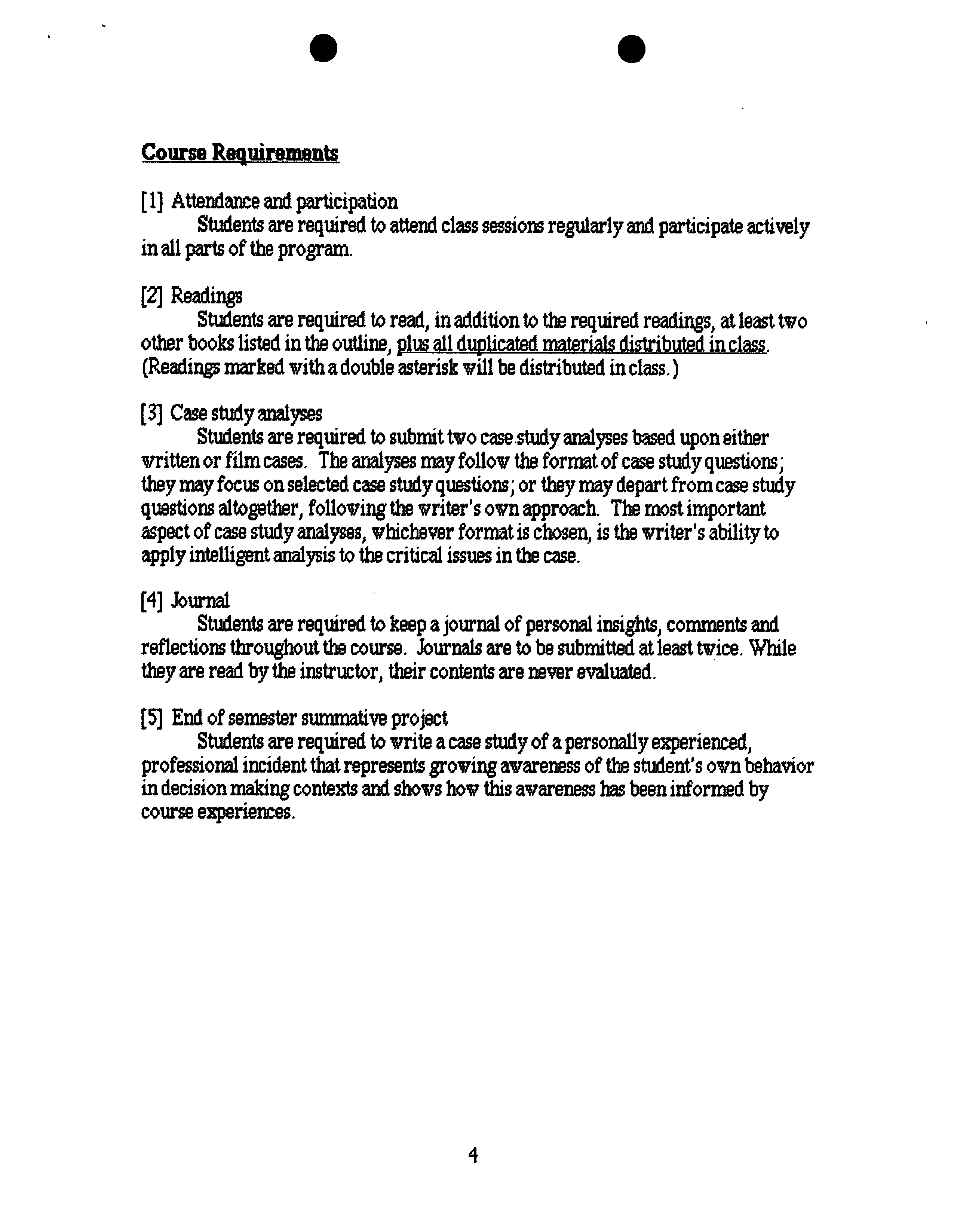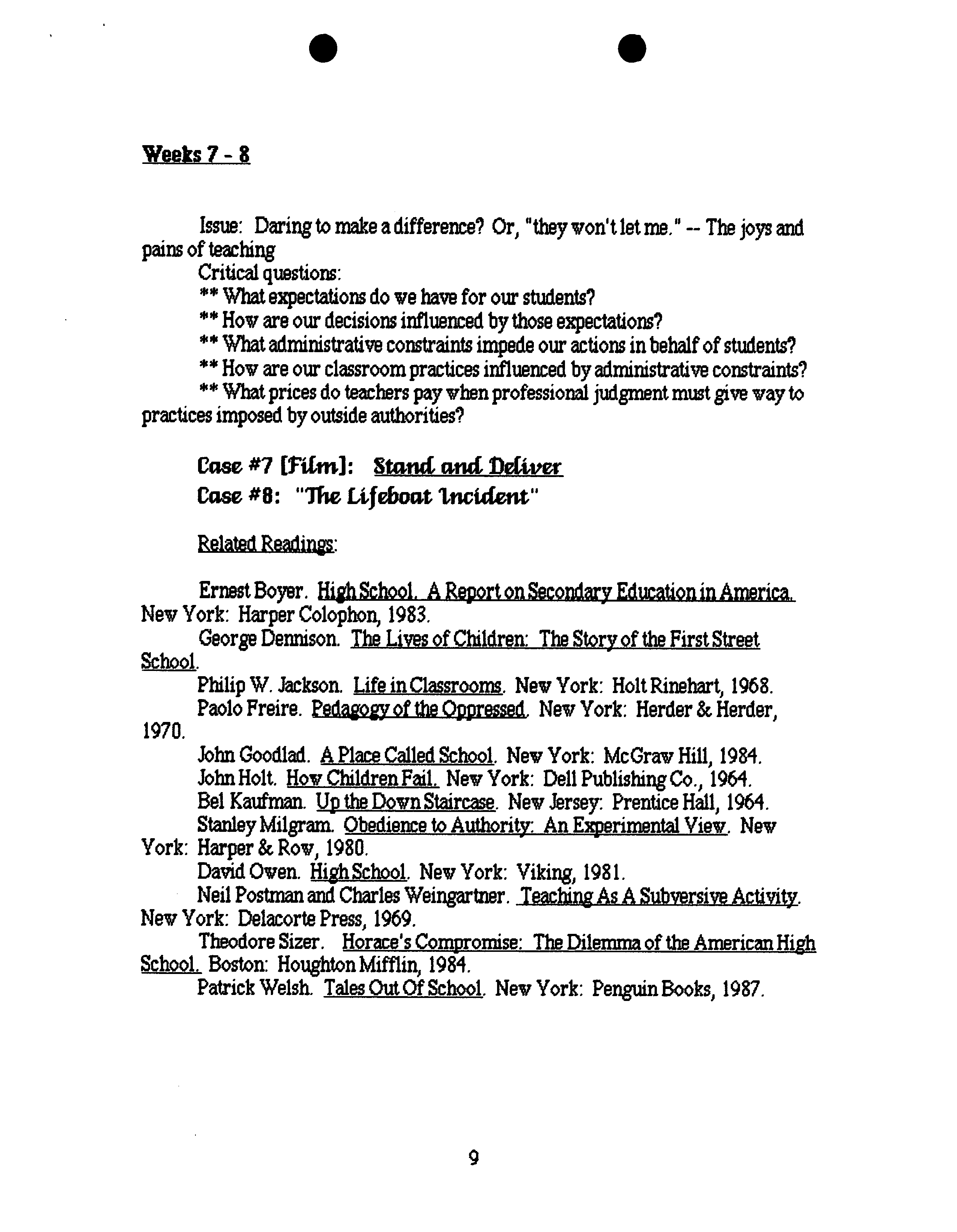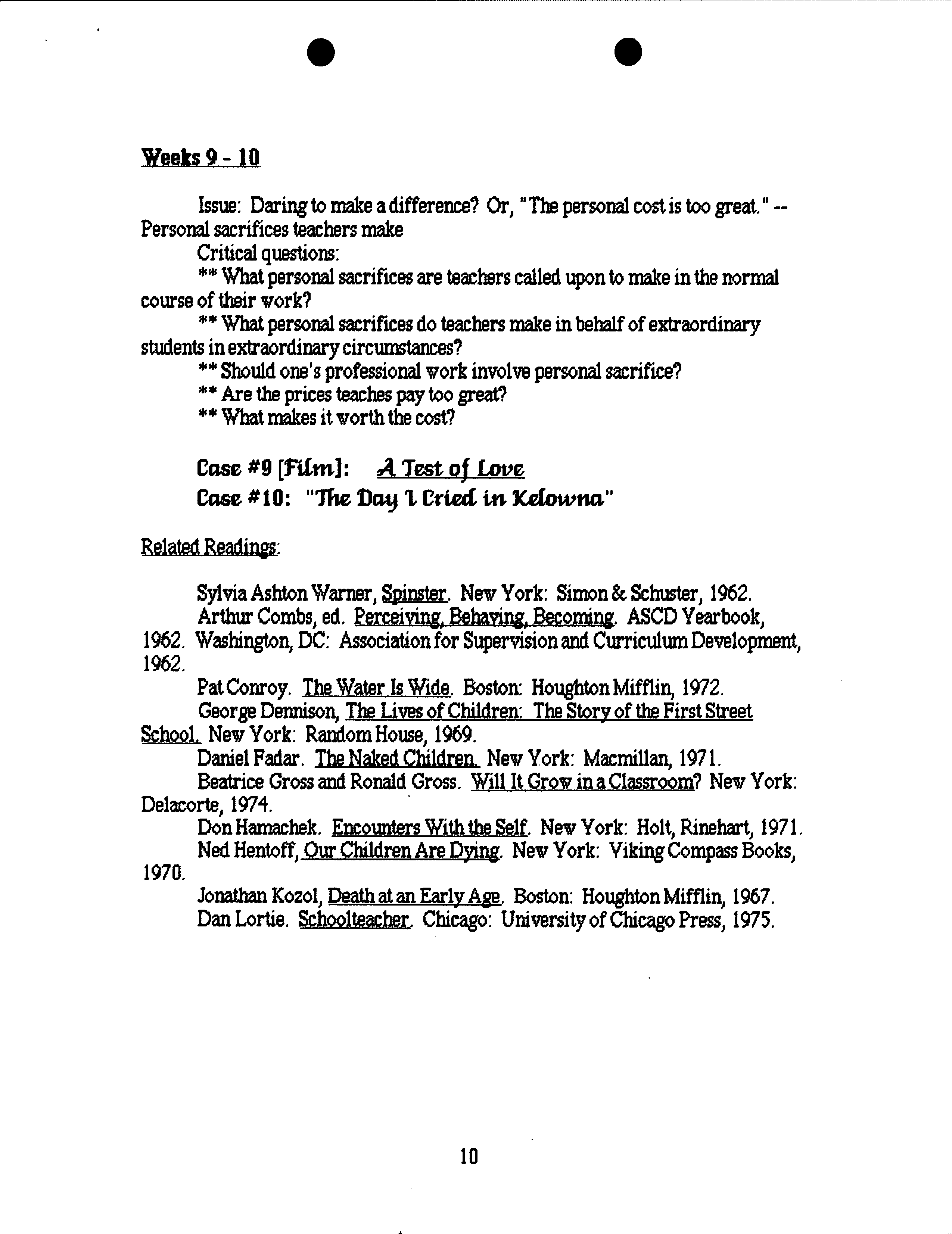| | - . ? .
- 1 1.16 rI -
- a....
- fliti
- Sprvng, 1989
- Or. Sc[ma Wtissermwin
- Introduction
- the thar' ? thewn 1n p s thatofz&yeiig1wddec'dizzg-
- Selma Wassermann "The Teacher As Decision Maker" TEACHER EDUCATION, 1976
- This course is offered for pre-service and in-service teachers vho vish
- In some professions, a variety of pressures -- political, social, emotional,
- . ? .
- This course uses contemporary film and readings to raise levels of awareness
- cognitive and affective factors
- 5. To develop more effective strategies to aid in decision making
- S ? S
- Course Requirements
- satisfaction of course requirements
- A grade of A indicates the student's completion of all course requirements
- vith demonstrated excellence in quality of performance
- requirements vith demonstrated good quality in performance
- A grade of C or lover indicates the completion of less than all basic
- requirements and/or less than demonstrated good quality in performance
- S ? .
- Schedule of Class Activities
- Required Reading:
- Case #1 [flltnJ: ThFwrft the Wind Case #2: ThvrngoJMLLaConner
- Thomas J. Flygare, "Some Thoughts on the Tennessee Textbook Case," hi
- Delta Kappan, February, 1987, pp. 474475•**
- Charles L. Glenn, "Textbook Controversies: A Disaster for Public Schools?"
- Phi Delta Kappan, February, 1987, pp. 45l_455.**
- Edward B. Jenkinson, "The Significance of the Decision in 'Scopes II" Phi
- Delta Kappan, February, 1987, pp. 445_450.**
- Edward B. Jenkinson, "The Nev Aga of Schoolbook Protest," Phi Delta
- 1967. John T. Scopes & James Presley. Centre of the Storm. Nev York: Holt,
- Issue: Conform? Or dare to be different? -- Acting in opposition to
- Cnse #3 [?tLmJ: Cotwac1r,
- George Dennison. The Lives of Children: The Story of the First Street
- School. New York: Random House, 1969.
- Jonathan Kozol. Death atan Early A ge. Boston: Houghton Mifflin, 1967.
- Stanley Milgram. Obedience to Authority. An Experimental View. New
- York: Harper & Row, 1980.
- New York: Delacorte Press, 1969.
- Weeks I6
- Issue: Conform? Or dare to be different? -- Innovation in response to pupil
- need
- Who should choose curriculum materials for the students in one's class?
- S ? .
- . ? S
- Case #9 [?tttnl: A Tcst of Love
- School, Nev York: Random House, 1969.
- Delacorte, 1974.
- . ? .
- Cam #12: "TheP[à.j"
- in The New York Times Book Review, March 22,1987.**
- November, 1986, pps. 58_65.**
- Phi Delta Kappan, February, 1986.**
- Elliott D. Landau, Sherrie Epstein and Ann Stone. Child Development
- Through Literature. New Jersey: Prentice Hall, 1972.
- Issue: Daring to make a difference? Or, "How much do I believe in myself
- ** How much do Ibelieve in myself and in what! am doing?
- believe in?
- Case #13 L?ttml: PassIonfor Life
- Information on teachers' decision-making processes can be found in the ERIC
- ED 231 786
- ED251 439
- ED 251 449
- S ? .
- ED 251 808
- Combs. 15 pp.
- ED 257 806
|

.
?
.
Back to top
1
1.16
rI
-
—
_
?
?
I'
uI
?
?
II
?
i
I
I
i ?
?
?
a....
a a
••
a.L1...I
U..
a
?
a a
?
Ia...
i.....
Nsesmom
?
r''''I
——
?
...a.
eggs ?
SOME
Back to top
fliti
-.
edocatia" 49S-4
CrWe&1 Ipciftpts h)
Tc&eJçij:
TW Tc&e1ici' As Deetsi )Raljcr
Sprvng, 1989
Or. Sc[ma Wtissermwin
Introduction
PffA?X t
?
ttzvzzr 1the ci crnon rkr
--
f
& O M
/he/zqth.c
sttrrn
,
g etthgand&miw.ij and
f/ia we at zJicfe
ot
t4t&
--is f
?
-zzthzg In
&1
?
ithe&arnaüç the
v hishetrthe1cvingto do. Moitvv in thepwsere of
iYi/7&nce t&
o Js 'dj2 4h L
a
nwmmkio,&theafckmrnysw fbaJiotorIy
is the pMwW&; hzitii.'dpiamic £thiorisaboi;/ ta,jdtw k' tth
amsz4ct oi e.nseassauf/
byp
rfu'piczimc £pzzdreshape the
Oet
the thar'
?
thewn 1n
p
s thatofz&yeiig1wddec'dizzg-
in /aFt4 p.tcwL cr rlivmntPfeszç vorJdprnt6en2ç dtheIiie
--
O /4?CA
Selma Wassermann
"The Teacher As Decision Maker"
TEACHER EDUCATION, 1976
This course is offered for pre-service and in-service teachers vho vish
to participate in the examination of the the decision making processes of teachers and
the kinds of influences that bear upon these processes.
One of the important aspects of professional functioning
is
the autonomy of
professionals to arrive at decisions based upon their sound professional judgment.
The ability to examine and interpret data, to analyze assumptions, and to project
potential consequences is considered a true mark of professional functioning.
In some professions, a variety of pressures -- political, social, emotional,
personal, temporal -- serve to influence professional judgment and consequently,
decision making. Such influence may have a deep and pervasive effect upon the
degrees of freedom and emotional health of professionals, upon their beliefs and
values about the profession itself, and upon their subsequent professional practice.
2
. ?
.
This course uses contemporary film and readings to raise levels of awareness
about factors influencing teachers decision making through examination of certain
critical incidents in teaching. Films, books, journal articles and written case studies
are supplemented by focused group discussions through which the many facets of
educational decision making may be more critically examined. It is through this
process
that
students become more critically aware of personal decision making in
their own professional/educational contexts.
1.
To promote greater understanding of and appreciation for the various and
complex factors that influence personal decision making. For example:
cognitive and affective factors
perceived and real consequences of decisions
personal beliefs and values underlying decisions
•• assumptions upon which decisions rest
real and perceived risks of deciding
the process of deliberation
the pressure of peer groups
assertiveness and avoidance in decision making
•• "vital lies and simple truths
"
-- the art of self deception in decision making
the impact of decisions on the SELF
2.
To promote awareness of the relationship between decision making and personal
empowerment
3.
To enable students to use increased understanding to inform personal decision
making, thereby promoting more critical awareness of personal decision making
4.
To increase personal tolerance for the risks in decision making and for the
consequences of decisions
5.
To develop more effective strategies to aid in decision making
3
S ?
S
Course Requirements
[1]
Attendance and participation
Students are required
to
attend class
sessions
regularly and participate actively
in all parts of the program.
[2] Readings
Students are required to read, in addition to the required readings, at least two
other books listed in the outline, plus all duplicated materials distributed in class.
(Readings marked with a double asterisk will be distributed in class.)
[3] Case study analyses
Students are required to submit two case study analyses based upon either
written or film cases. The analyses may follow the format of case study questions;
they may focus on selected case study questions; or they may depart from case study
questions altogether, following the writer's own approach. The most important
aspect of case study analyses, whichever format is chosen, is the writer's ability to
apply intelligent analysis to the critical issues in the case.
[4] Journal
Students are required
to
keep a journal of personal insights, comments and
reflections throughout
the
course. Journals are to be submitted at least twice. While
they are read by the instructor, their contents are never evaluated.
[5] End of semester summative project
Students are required
to
write a case study of a personally experienced,
professional incident that represents growing awareness of the student! s own behavior
in decision making contexts and shows how this awareness has been informed by
course experiences.
4
S
Students are evaluated on the
basis
of their fulfillment of course requirements.
The folloving
criteria are used in the final evaluation:
the degree to vhich the student has satisfied course requirements, based
upon the instructor's evaluation
the quality of the
student's
york
the student's non-defensive avareness of both quality of y ork and
satisfaction of course requirements
A grade of A indicates the student's completion of all course requirements
vith demonstrated excellence in quality of performance
A grade of B indicates the student's completion of all basic course
requirements vith demonstrated good quality in performance
A grade of C or lover indicates the completion of less than all basic
requirements and/or less than demonstrated good quality in performance
S
?
.
Schedule of Class Activities
Required Reading:
1981. Ann Berlak and Harold Berlak, Dilemmas of Schooling. London: Methuen,
Selma
Wassermann,
"The Teacher As Decision Maker," Teacher Education,
Spring, 1972.**
Selma Wasserrnazm, "Teaching Strategies: What's Important? Childhood
Education, Fall, 1988.**
Weeks 1-2
Issue: Conform? Or dare to be different? -- Teaching content that contravenes
the law
Critical questions:
** What are a teacher's options with respect to choosing what to teach?
Should teachers always stay within the established curriculum guidelines?
** When is it all right to extend the curriculum beyond those guidelines?
** Who should make curriculum decisions?
Case #1 [flltnJ: ThFwrft the Wind
Case #2: ThvrngoJMLLaConner
Related Readings:
David Bercum and Douglas Wertheimer. A Trust Betrayed. The Keegstra
Affair. Toronto: Seal Books, 1987.
Thomas J. Flygare, "Some Thoughts on the Tennessee Textbook Case," hi
Delta Kappan, February, 1987, pp. 474475•**
Charles L. Glenn, "Textbook Controversies: A Disaster for Public Schools?"
Phi Delta Kappan, February, 1987, pp. 45l_455.**
Edward B. Jenkinson, "The Significance of the Decision in 'Scopes II" Phi
Delta Kappan, February, 1987, pp. 445_450.**
Edward B. Jenkinson, "The Nev Aga of Schoolbook Protest," Phi Delta
Kappan, September, 1988.**
1967. John T. Scopes & James Presley. Centre of the Storm. Nev York: Holt,
S
Issue: Conform? Or dare to be different? -- Acting in opposition to
administrative directives
Critical
questions:
** What are a teacher's options in deciding about what curriculum experiences
are best for his or her students?
** Should teachers always obey the administrative directives?
When is it all right to take the decision into your own hands?
Who should decide about what activities are best for one's own students?
Cnse #3 [?tLmJ: Cotwac1r,
Cuse #4: "fltj 1rIetuL Connie"
Related Reading:
Pat Conroy. The Water is
Wide.
Boston: Houghton Mifflin, 1972.
George Dennison. The Lives of Children: The Story of the First Street
School. New York: Random House, 1969.
Daniel Fadar. The Naked Children. New York: Macmillan, 1971.
Ned Hentoff. Our Children Are Dying. New York: Viking Compass Books,
1970.
James Herndon. The Way It Spozed to Be. New York: Simon & Schuster,
1968.
Jonathan Kozol. Death atan Early A
ge.
Boston: Houghton Mifflin, 1967.
Herbert Kohl. Thirty-Six Children. New York: New American Library,
1967.
Stanley Milgram. Obedience to Authority. An Experimental View. New
York: Harper & Row, 1980.
Neil Postman and Charles Weinrtner. Teachin
g
As A Subversive Activity.
New York: Delacorte Press, 1969.
7
.
?
.
Weeks I6
Issue: Conform? Or dare to be different? -- Innovation in response to pupil
need
Critical questions:
What are a teacher's options
vith
respect to deciding to develop nev
curriculum that is more appropriate to student needs?
** Should teachers alvays teach
vith
the materials that are officially issued?
When
is
it all
right
to depart from officially sanctioned texts?
Who should choose curriculum materials for the students in one's class?
Caw
#5
[liLtnJ:
S4vtc
Case
# 6: "Ga.rtj"
Related Readin:
Sylvia Ashton-Warner. Spinster. Nev York: Simon& Schuster, 1962.
Sylvia Ashton-Warner. Teacher. Nev York: Simon & Schuster, 1963.
Sylvia Ashton-Warner. Myself. Nev York: Simon & Schuster, 1967.
Sylvia Ashton-Warner. Spearpoint. Nev York: Knopf, 1972,
Sylvia Ashton-Warner. I Passed This Way. Nev York: Knopf, 1979.
Lynley Hood. Sylvia!
A
Biography. London: Penguin Books, 1988.
8
S ? .
Weeks
J
Issue:
Daring to make a difference? Or,
"they
won't let me." -- The joys and
pains of teaching
Critical questions:
** What expectations do we have for our students?
How are our decisions influenced by
those
expectations?
What administrative constraints impede our actions in behalf of students?
**Hov are our classroom practices influenced by administrative constraints?
What prices do teachers pay when professional judgment must give way to
practices imposed by outside authorities?
Case
#7
[Film]: Sttm4 and
T)vLi,ver
Case #8: "The
f4thocitliwtáent"
Ernest Boyer. High School. A Report on Secondary Education in America.
Nev York: Harper Colophon, 1983,
George Dennison. The Lives of Children: The Story of the First Street
School.
Philip W. Jackson. Life in Classrooms. Nev York: Holt Rinehart, 1968.
Paolo Freire. Pedagogy of the Oppressed. Nev York: Herder & Herder,
1970.
John Goodlad. A Place Called School. Nev York: McGraw Hill, 1984.
John Holt. How Children Fail. Nev York: Dell Publishing Co., 1964.
Bel Kaufman. Up the Down Staircase. Nev Jersey: Prentice Hall, 1964.
Stanley Milgram. Obedience to Authority: An Experimental View. Nev
York: Harper & Row, 1980,
David Oven. High School. Nev York: Viking, 1981.
Neil Postman and Charles Weirzgartner. Teaching As A Subversive Activity.
New York: Delacorte Press, 1969.
Theodore Sizer. Horace's Compromise: The Dilemma of the American High
School. Boston: Houghton Mifflin, 1984.
Patrick Welsh. Tales Out Of School. Nev York: Penguin Books, 1987.
.
?
S
Issue: Daring to make a difference? Or, "The personal cost
is
too great.
0 --
Personal sacrifices teachers make
Critical questions:
What personal sacrifices are teachers called upon to make in the normal
course of their work?
What personal sacrifices do teachers make in behalf of extraordinary
students in extraordinary
circumstances?
Should one's professional work involve personal sacrifice?
Are the prices teaches pay too great?
What makes it worth the cost?
Case
#9
[?tttnl: A Tcst of Love
Case #10: "The 1)a4J 1, Crüd
i,n
J(clowna"
Sylvia Ashton Warner, Spinster. Nev York: Simon & Schuster, 1962.
Arthur Combs, ed. Perceiving, Behaving, Becoming. ASCD Yearbook,
1962. Washington, DC: Association for Supervision and Curriculum Development,
1962,
Pat Conroy. The Water Is Wide. Boston: Houghton Mifflin,
1972.
George Dennison, The Lives of Children: The Story of the First Street
School, Nev York: Random House, 1969.
Daniel Fadar. The Naked Children, Nev York: Macmillan, 1971.
Beatrice Gross and Ronald Cross. Will It Crow in a Classroom? Nev York:
Delacorte, 1974.
Don Hamachek. Encounters With the Self. Nev York: Holt, Rinehart, 1971.
Ned Hentoff, Our Children Are Dying. Nev York: Viking Compass Books,
1970,
Jonathan Kozol, Death at an Early Age. Boston: Houghton Mifflin, 1967.
Dan Lortie. Schoolteacher. Chicago: University of Chicago Press, 1975.
10
. ? .
Issue: Daring to make a difference? Or, "creating students in my own
image."
Critical questions:
What kinds of teacher actions empower students as individuals?
What kinds of teacher actions promote student conformity?
** What satisfactions do teachers get when students emulate them?
** What satisfactions do teachers get when students are liberated?
** What does it take for a teacher to allow the liberation/empowerment of his
or her students?
Case #11 [?ttinl:
E4uw,tf,n9
1Ut
Cam #12: "TheP[à.j"
Houston
A.
Baker, Jr. "What Charles Knew: Homage to an English Teacher"
in The New York Times Book Review, March 22,1987.**
John Barth, "Teacher: The Making of a Good One," in Harper's Magezine,
November, 1986, pps. 58_65.**
Michael Csikszentmihalyi and Jean McCormack, "The Influence of Teachers,"
Phi Delta Kappan, February, 1986.**
Bernard Johnston. The Literature of Learning. New York: Holt, Rinehart,
1971.
Elliott D. Landau, Sherrie Epstein and Ann Stone. Child Development
Through Literature. New Jersey: Prentice Hall, 1972.
George Orwell, Such, Such Were the Joys. New York: Harcourt Brace, 1945.
Louis D. Rubin, Jr. (editor) An Apple for My Teacher: Twelve Authors Tell
About Teachers Who Made the Difference. North Carolina: Algonquin Books of
Chapel Hill, 1987.
Muriel Spark, The Prime of Miss Jean Brodie. London: Penguin, 1968.
Richard Yates, "Doctor Jack-o'-Lantern," in Eleven Kinds of Loneliness.
New York: Delta Books, 1982.
11
.
?
I1J
Week 1 3
Issue: Daring
to
make a difference? Or, "How much do I believe in myself
and in what lam doing?"
Critical questions:
** On what issues am I prepared
to
compromise?
On what issues amlprepared
to
take a strong stand?
** How much do Ibelieve in myself and in what! am doing?
On what issues would Ibe willing to put my job on the line?
What personal prices do I pay for my compromises on the issues I deeply
believe in?
What personal gains do I make for my taking a stand on the issues I deeply
believe in?
Case #13 L?ttml: PassIonfor Life
Since this is the last class, there are no related readings or written case
supporting this film.
Information on teachers' decision-making processes can be found in the ERIC
documents described below:
ED 231 786
CLASSROOM MANAGEMENT AND ORGANIZATION: Teacher Decisions for
Establishing a Learning Community Classroom. Joyce Putnam. 58 pp.
ED 243 846
A GROUNDED THEORY STUDY OF TEACHERS' DECISION MAKING. Walter
C. Parker and Nathalie J. Gehrke. 22 pp.
ED251 439
CURRICULUM DECISION MAKING AND THE BEGINNING TEACHER. Report
No. 9058. Sharon F. O'Neal and James V. Hoffman. 37 pp.
ED 251 449
TEACHERS' THOUGHT PROCESSES. Occasional Paper No. 72. Christopher M.
Clark and Penelope L. Peterson. 159 pps.
12
S ?
.
ED 251 451
A DESCRIPTIVE STUDY OF THE PREACTIVE AND INTERACTIVE
DECISION MAKING OF AN EXPERT CLASSROOM TEACHER. Research Series
No. 148. Joyce Putnam and G. Gerald Duffy. 34 pp.
ED 251 808
BEGINNING TEACHERS: Hov Do They Make Decisions About
Reading s ?
Martha
Combs. 15 pp.
ED 257 806
THE STRUCTURE OF SCHOOL: Teachers and
Authority.
Robert E. Reir. 37 pp.
13













